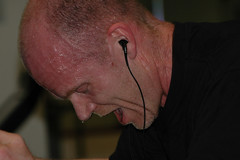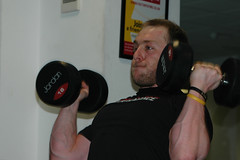This article has been prepared by Chiropractor Colin Wellsted. If you have any questions regarding its content, please feel free to comment below or get in touch with Colin via email at colinwellsted@hotmail.co.uk. Colin also provides free chiropractic consultations and assessments every Tuesday lunchtime and evening at Factory Gyms.
Concerned by a non-descript knee pain?
Knee pain can be worrying. Particularly as it often appears for no apparent reason and it is often difficult to find an obvious cause. For those who run it can be really confusing as one knee can hurt, whilst the other does not. Normal activity is affected, gym routines are compromised and climbing or descending stairs and getting out of chairs all become difficult and maybe painful on the knee. The vast majority of knee pain can be traced to a number of factors:
- direct trauma (the bad tackle or skiing accident);
- degenerative anatomical changes (osteoarthritis – the gradual achy stiff knee); or
- functional issues, where undue stress is placed on the knee due to one or more aspects of the lower limb not working properly.
Whilst injury to the knee occurs often during sporting activities it should be noted that a high percentage of these occur without contact. For example 72% of Anterior Cruciate Ligament ruptures are reported to involve no contact (Michael Owen ACL injury – 2006 World Cup). Experiencing knee pain when running, squatting or jumping, could suggest that an intrinsic degree of instability in high load situations is the likely cause, particularly if there is no history of trauma or obvious degenerative changes.
 It’s a unique joint…
It’s a unique joint…
The knee is a simple “hinge” joint, with a few clever tricks. Uniquely, the joint it has two incredibly strong ligaments (ACL / PCL) that keep the joint “centred” through all its movements, especially when excessive weight is added, for example in the squat position. The Knee “locks” when extended so that you do not have to use enormous amounts of effort to keep the leg straight whilst standing. As simple as it is, it is often the “victim” of other issues within the lower limb from foot to hip. Undue stress in the knee is often the result of dysfunction in the hip, foot, ankle or lower limb muscles. Some examples listed below:
- Hyperpronation of the foot (collapsing arches when walking)
- Reduced muscle length (tight muscles)
- Abnormal hamstrings: quadriceps ratio (over dominant muscle groups)
- Faulty motor control (poor control of knee movement)
Impact of the Foot & Ankle
Foot and ankle problems can lead to pain felt in and around the patella (kneecap), particularly if you are susceptible to early pronation (flattening of the arch) during the stance phase of running.
Reduced Muscle Length
Conversely how difficult or easy is it for you to touch your toes? Or when you walk or perform leg exercises (squats, lunges, glut raises) do the front of your thighs or calves always hurt the most? Reduced muscle length around the hip, thigh or calf, all affect the balance and movement pattern of the knee. Shortened quadriceps (thigh) and or shortened gastrocnemius (calf) muscles are predictive of patella-femoral-pain-syndrome. If the muscle strength ratio is out of balance, particularly in the thigh and hip, the stresses of maintaining the congruity of the knee joint can affect the ligaments around the joint (inside edge and outside edge of the knee) causing pain.
Faulty Motor Control
Faulty motor control refers to a lack of control of knee movement either in the muscles or the joints. Whilst attempting one legged squats, does your knee “wobble” from side to side? This could indicate a lack of control, particularly if there is pain in the knee.
Other than pain, what is the impact of knee injury??? 
Research suggests that the effects of a knee injury on lower limb function look very similar to problems that cause knee problems. The list is as follows and is very similar to the above list:
It’s a viscous circle if the disfunction of the lower limb is not addressed.
In summary:
Colin Wellsted MChiro






